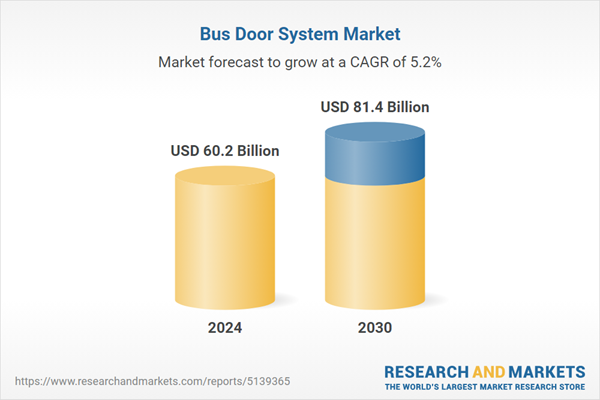The global market for Bus Door System was valued at US$60.2 Billion in 2024 and is projected to reach US$81.4 Billion by 2030, growing at a CAGR of 5.2% from 2024 to 2030. This comprehensive report provides an in-depth analysis of market trends, drivers, and forecasts, helping you make informed business decisions.
Global Bus Door System Market - Key Trends and Drivers Summarized
Why Are Bus Door Systems Crucial to Public Transportation?
Bus door systems play a pivotal role in the functionality and efficiency of modern public transportation, but why are they so essential? The design and operation of these doors significantly impact the safety, accessibility, and overall passenger experience. Bus door systems are responsible for managing the smooth entry and exit of passengers, which is crucial in maintaining timely schedules, especially during peak hours. They are engineered to handle frequent use, ensuring that doors open and close quickly and safely without causing delays or hazards. Moreover, bus door systems are vital for ensuring the safety of passengers, preventing accidents, and ensuring that people board and exit the vehicle efficiently. Modern door systems come equipped with advanced sensors and automation that detect obstructions, ensuring no one is trapped or injured during door operation. Additionally, bus door systems must comply with accessibility standards, making public transportation more inclusive for individuals with disabilities or mobility issues. From traditional manual doors to fully automated sliding or folding doors, these systems are integral to the smooth operation of buses in cities around the world.What Are the Key Types of Bus Door Systems and Their Uses?
What are the different types of bus door systems, and how do they function in varying contexts? There are several types of bus door systems, each designed to meet specific operational and spatial requirements. The most common types include sliding doors, folding doors, and swing plug doors. Sliding doors, often seen in low-floor buses, offer quick, smooth operation and provide a wider opening, allowing for faster boarding and exit, especially for passengers with mobility aids like wheelchairs or strollers. Folding doors are typically used in buses with more limited space and are known for their ability to fold inwards or outwards to maximize interior capacity. These are especially useful in older bus models or in regions where narrow streets require compact bus designs. Swing plug doors are more advanced, combining a swing and plug mechanism to create a tight seal when closed, enhancing both safety and energy efficiency by minimizing air leakage. Beyond these basic types, some buses are equipped with pneumatic or electric systems that automate door control, reducing the need for manual intervention by drivers. The choice of door system depends largely on the bus design, passenger volume, and specific operational needs, with each type offering distinct advantages in different transit scenarios.How Have Technological Innovations Transformed Bus Door Systems?
How have technological advancements influenced the evolution of bus door systems? Over the years, bus door systems have evolved significantly, primarily due to advances in automation, safety features, and materials engineering. The integration of sensors and automation technology has been one of the most transformative developments. Modern bus doors are equipped with sensors that detect the presence of passengers or objects, ensuring that doors do not close when obstructions are detected. This enhances safety by reducing the risk of injury, especially in crowded urban environments where accidents involving bus doors were more common in the past. Additionally, automated door control systems have simplified the driver's role, allowing for centralized control over the opening and closing of doors, which reduces human error and improves operational efficiency. These systems are often integrated with the bus's onboard electronics, offering features like synchronized door operation and diagnostics that alert maintenance teams to potential issues. Advances in materials have also improved the durability and energy efficiency of bus doors. Lightweight materials such as aluminum and composites are now commonly used, reducing the overall weight of the bus and contributing to better fuel efficiency. The use of advanced materials also improves the reliability and longevity of door systems, reducing maintenance costs and improving the safety and comfort of passengers.What Are the Key Factors Fueling Growth in the Bus Door System Market?
The growth in the bus door system market is driven by several factors, reflecting technological advancements, regulatory requirements, and changing consumer expectations. One of the primary drivers is the increasing demand for safer and more reliable public transportation systems, particularly in urban areas where high passenger volumes require efficient door operations. With growing global urbanization, more cities are expanding their public transit networks, which directly boosts the demand for sophisticated bus door systems that can handle high-frequency use. Another critical factor is the push for enhanced safety and compliance with international safety standards. Regulatory bodies now require buses to be equipped with advanced safety features, including door systems that prevent accidents and injuries. This has spurred innovations in sensor technology and automation, driving market growth as manufacturers invest in upgrading existing fleets with modern, compliant systems. Technological advancements, particularly in automation and energy-efficient designs, are also key drivers. The trend toward electric and hybrid buses has increased the need for lightweight, energy-efficient door systems that reduce the overall energy consumption of the vehicle. Additionally, consumer expectations for accessible and comfortable public transport are shaping the market, as there is an increasing focus on making buses more user-friendly for passengers with disabilities, the elderly, and those traveling with young children. As these trends continue, the bus door system market is expected to expand, driven by a combination of safety, technological innovation, and evolving transit needs across global markets.Report Scope
The report analyzes the Bus Door System market, presented in terms of market value (US$ Thousand). The analysis covers the key segments and geographic regions outlined below.Segments
Type (Pneumatic, Electrical).Geographic Regions/Countries
World; United States; Canada; Japan; China; Europe (France; Germany; Italy; United Kingdom; Spain; Russia; and Rest of Europe); Asia-Pacific (Australia; India; South Korea; and Rest of Asia-Pacific); Latin America (Argentina; Brazil; Mexico; and Rest of Latin America); Middle East (Iran; Israel; Saudi Arabia; United Arab Emirates; and Rest of Middle East); and Africa.Key Insights:
- Market Growth: Understand the significant growth trajectory of the Pneumatic Door System segment, which is expected to reach US$60.5 Billion by 2030 with a CAGR of a 5.5%. The Electrical Door System segment is also set to grow at 4.1% CAGR over the analysis period.
- Regional Analysis: Gain insights into the U.S. market, valued at $15.8 Billion in 2024, and China, forecasted to grow at an impressive 7.9% CAGR to reach $18.3 Billion by 2030. Discover growth trends in other key regions, including Japan, Canada, Germany, and the Asia-Pacific.
Report Features:
- Comprehensive Market Data: Independent analysis of annual sales and market forecasts in US$ Million from 2024 to 2030.
- In-Depth Regional Analysis: Detailed insights into key markets, including the U.S., China, Japan, Canada, Europe, Asia-Pacific, Latin America, Middle East, and Africa.
- Company Profiles: Coverage of major players such as Bode Sud S.p.A., Continental AG, Masats, Rotex Automation Limited, Schaltbau Holding AG and more.
- Complimentary Updates: Receive free report updates for one year to keep you informed of the latest market developments.
Why You Should Buy This Report:
- Detailed Market Analysis: Access a thorough analysis of the Global Bus Door System Market, covering all major geographic regions and market segments.
- Competitive Insights: Get an overview of the competitive landscape, including the market presence of major players across different geographies.
- Future Trends and Drivers: Understand the key trends and drivers shaping the future of the Global Bus Door System Market.
- Actionable Insights: Benefit from actionable insights that can help you identify new revenue opportunities and make strategic business decisions.
Key Questions Answered:
- How is the Global Bus Door System Market expected to evolve by 2030?
- What are the main drivers and restraints affecting the market?
- Which market segments will grow the most over the forecast period?
- How will market shares for different regions and segments change by 2030?
- Who are the leading players in the market, and what are their prospects?
Some of the 43 major companies featured in this Bus Door System market report include:
- Bode Sud S.p.A.
- Continental AG
- Masats
- Rotex Automation Limited
- Schaltbau Holding AG
- Ventura Systems BV
Table of Contents
I. METHODOLOGYII. EXECUTIVE SUMMARY2. FOCUS ON SELECT PLAYERSIII. MARKET ANALYSISIV. COMPETITION
1. MARKET OVERVIEW
3. MARKET TRENDS & DRIVERS
4. GLOBAL MARKET PERSPECTIVE
UNITED STATES
CANADA
JAPAN
CHINA
EUROPE
FRANCE
GERMANY
ITALY
UNITED KINGDOM
SPAIN
RUSSIA
REST OF EUROPE
ASIA-PACIFIC
AUSTRALIA
INDIA
SOUTH KOREA
REST OF ASIA-PACIFIC
LATIN AMERICA
ARGENTINA
BRAZIL
MEXICO
REST OF LATIN AMERICA
MIDDLE EAST
IRAN
ISRAEL
SAUDI ARABIA
UNITED ARAB EMIRATES
REST OF MIDDLE EAST
AFRICA
Companies Mentioned (Partial List)
A selection of companies mentioned in this report includes, but is not limited to:
- Bode Sud S.p.A.
- Continental AG
- Masats
- Rotex Automation Limited
- Schaltbau Holding AG
- Ventura Systems BV
Table Information
| Report Attribute | Details |
|---|---|
| No. of Pages | 243 |
| Published | March 2025 |
| Forecast Period | 2024 - 2030 |
| Estimated Market Value ( USD | $ 60.2 Billion |
| Forecasted Market Value ( USD | $ 81.4 Billion |
| Compound Annual Growth Rate | 5.2% |
| Regions Covered | Global |









